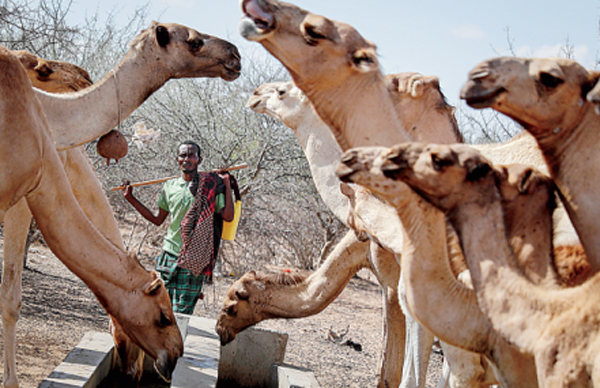Severe E. African drought takes heavy toll on wildlife
By EDITH MUTETHYA in Nairobi | China Daily Global | Updated: 2022-03-25 11:10

The severe drought in East Africa following three consecutive poor rainy seasons has not only put millions of people on the brink of starvation, but is also threatening rich biodiversity in the region as wildlife die from the lack of water and forage.
It is hard to estimate how many wild animals have died because of the two-year drought in the region, the worst in 40 years, but in Kenya alone, 62 elephants succumbed to the drought between August and December, Najib Balala, Kenya's secretary for tourism and wildlife, told Parliament this month.
In a tweet in November, the Sabuli Wildlife Conservancy in the East African country said 11 giraffes died within a week in Wajir, northern Kenya, due to the drought.
In a virtual news briefing in February, Rein Paulsen, director of emergencies and resilience at the United Nations Food and Agriculture Organization, said after returning from a tour to the Horn of Africa that he saw wildlife and livestock carcasses by the roadside.
Steve Itela, chief executive officer of the Conservation Alliance of Kenya, an umbrella body for conservation organizations, said he came across many wildlife carcasses during his tour of various conservation areas.
Itela said that nonmigratory species like impalas, hippopotamuses and buffaloes have suffered most from the drought, and the hardest hit regions in Kenya were Laikipia, Isiolo, Marsabit, Wajir, Mandera and parts of Garissa.
"Unlike human beings, wildlife and livestock are so much dependent on rainy seasons that when there is a delay or a rainfall pattern change, they are affected, having limited access to water and forage," Itela said.
The drought has also increased human-wildlife conflicts, he said, noting that many hippos have left the rivers and wandered around community land looking for pastures.
Last year, more than 15 people illegally fishing at Lake Naivasha, northwest of the Kenyan capital, Nairobi, were killed by hippos, The Star newspaper reported.
More than 10 hippos were also killed within one week in July at Lake Ol Bollosat, in Kenya's Nyandarua county.
Frank Pope, the chief executive officer of Save the Elephants, a Kenya-based charity, said dangerous human-elephant encounters have also increased, particularly in northern Kenya.
Pope said these drought-related run-ins are exacerbated by overgrazing. "As the threat of poaching has receded in northern Kenya, conflict between humans and elephants has grown," he said.
"In Samburu, nearly half as many elephants were shot by herders last year without their tusks being taken as were killed at the height of the poaching outbreak. Most of this human-elephant conflict is due to increased competition for grazing and access to water."
Pope said reducing dangerous human-elephant encounters is a key focus of Save the Elephants.
"We are continuing to build a toolbox of methods to promote coexistence between our species, and, for the first time, we are sharing these solutions through the Elephant Crisis Fund across Africa with our partners, the Wildlife Conservation Network," he said.
"Landscape planning is also critical for creating sustainable solutions for humans and elephants."
Itela said wildlife haven't received adequate attention during this severe drought, because most of the attention has been focused on hunger-stricken communities.
In addition to the food and water shortages caused by drought, fire also poses a severe threat to wildlife survival, he said.
"When there is drought, wildlife require a lot of water and grass being provided to them. When droughts hit, fires become rampant in wildlife areas, destroying the limited available grass and vegetation," he said.
In February, a huge fire destroyed more than 40,000 hectares of Kenya's Aberdares National Park. Kenya Wildlife Services blamed the two-day fire on illegal honey harvesters.
To reduce the impact of drought on wildlife, Itela said governments and society at large should expand the use of rain-collecting water pans.
Governments, he said, should also increase forest cover by growing species that are tolerant to drought, like the prosopis juliflora shrub, popularly known in Kenya as the mathenge plant. The species provides a good source of protein for animals.
Itela also suggested replacing generators with solar power to operate water pumps because it would reduce the cost.
"It has been a challenge for the communities to provide water through pumping because of the operational costs driven by the skyrocketing diesel prices," he said.
"We are also pushing the government to do a risk-impact assessment to find out what the risk of drought on wildlife has been and then develop a mitigation strategy. Once the impact assessment is clear, resources will be put together so that the next disaster does not take us by surprise."
edithmutethya@chinadaily.com.cn
























